Super Sonico: The Animation Review
"A lot better then it had any right to be"
Super Sonico is the mascot for Nitroplus, a Japanese software company who make visual novel video games and the face of a music festival sponsored by the company. That description would make anyone think that an anime series based on the character would be an awful idea, but it turns out she leads a sweet if light series.
Super Sonico is an intelligent marine biology student who is also a lead singer and guitar player for the three piece band - First Astronomical Velocity. She also helps her grandma at her bar and grill, and is an aspiring big breasted model with a smile that can brighten the world…. So your typical Japanese girl. With her band mates Suzu and Fuuri and the people closest to her, Sonico sets out to find success doing the thing she loves - playing rock music.
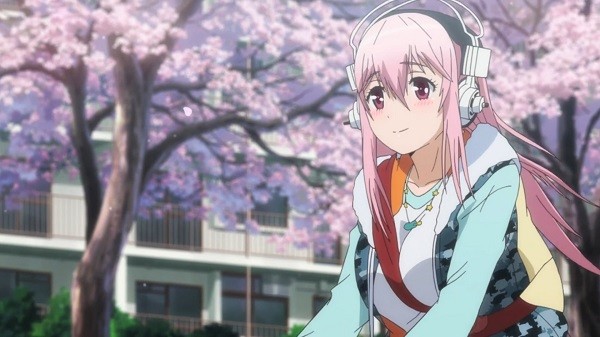
Unlike other anime series which have been reviewed by this website -
Super Sonico: The Animation is a looser collection of episodes. Even though the episodes have some connection to each other they could be watched independently without much trouble or prior knowledge. The stories themselves are light-hearted if inconsequential affairs where Sonico prepare for gigs, going on modelling contracts, going on vacation, finding a kitten and saving the shopping district at Christmas.
Some episodes are more dramatic and heartfelt and others are more comedic in tone. The most emotional and best episode in the series is the fourth episode "Daydream" telling the story about how Sonico got her guitar in junior high. The heart of the episode is Sonico's relationship with an older student who teaches her how to play and gives the young teenager the confidence she needs. Other emotional episodes are the seventh episode "Star Rain", where Sonico travels to northern Japan to find inspiration and meets numerous people on the way and the Christmas episodes that ends the series. These are episodes that succeed in producing a warm internal fuzzy feeling at the end.
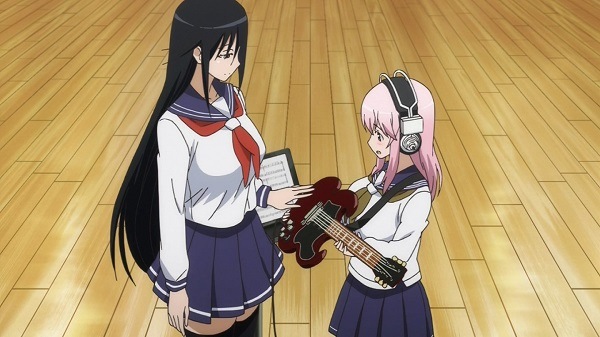
The best of the comedic episodes is episode (or session) eight - "Super Sonico Murder Case" where Sonico is found unconscious in a locked room and Suzu's enthusiastic little sister Ena tries to play detective. This episode is the most overt in using anime tropes, using a simplistic, cartoony style of animation when Ena talks about her deductions and Ena has a wonderful anime introduction when she puts on her Sherlock Holmes deerstalker hat and stands in her dramatic pose. The third episode "Sonico Goes to Okinawa" parodies Super Sentai shows (the Japanese footage used in "Power Rangers" shows) and takes a swipe at the use of tentacle porn in anime.
The series is fairly grounded because of its focus on a normal group of people and the trials of daily tasks, but it doesn't mean that the series cannot have more outlandish moments. The best example is the sixth episode where the band goes on a cruise ship that ends up being infested with zombies. This comes completely out of left-field considering the rest of the series. Sonico's modelling manger, Kitamura, also appears to be from another anime show - dressed in a hannya mask, has pointed orange hair and carries a katana.
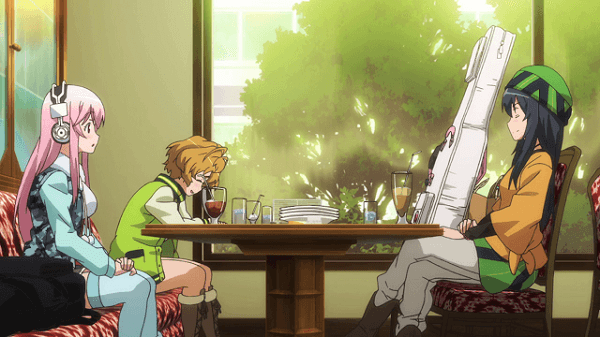
The winning feature of
Super Sonico: The Animation is its likable cast of characters. Sonico herself is Mary Sue - she's a musician, a successful model and a student: even her teacher says she would be the perfect student if she could show up on time. Her only faults are that she gets embarrassed easily - too keen to apologize, too eager to help others and oversleeps. These are not major faults and she improves the lives of everyone she comes into contact with. Despite Sonico's lack of major issues she has a lovely on-screen presence and it is easy to see why people are drawn to her.
Two of the best supporting characters in Super Sonico are Suzu and Kitamura. Suzu is a dominating young woman who doesn't let anything get in her way, while Kitamura is at his best when he intimidates anyone trying to take advantage of Sonico. Fuuri is a character that everyone could easily envy because of her metabolism - being able to eat like a pig but does not get fat. Even though Ena only appears for one episode she was a fantastically energetic girl and a delight to see.
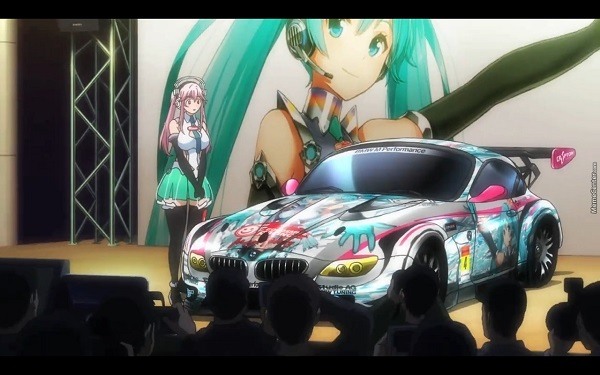 Super Sonico: The Animation
Super Sonico: The Animation also has excellent animation throughout, mixing traditional hand drawn animation and CGI. The first episode opens with a gorgeous collection of establishing shots, showing people and animals in a park while cherry blossom leaves fall before meeting Sonico. The series is filled with moments like these - episode seven being the best example as it shows Sonico on her travels, the final concert that uses a CGI style of animation and episode six shows some horror influences when the girls run away from the zombies. One of the most famous aspects of the series was its end-credit sequences - having a different one for each episode. Some work better than others - ranging from Sonico dancing or being in a bikini - a homage to Michael Jackson's 'Thriller', Sonico becoming the 50-foot tall woman and a Sonico doll comes to life. These sequences are a great little treat to end the episodes.
It is advisable to watch the series in Japanese because the voice acting in the American dub is a mixed back. Sonico was voiced by Jessica Nigri, a celebrity cosplayer and Youtuber. Nigri was enthusiastic but clearly was not a trained voice actor. The American voice for Kitamura did not much match the character, it needed something more intense - even at his kindest - and Luci Christian, an experienced voice actor, who played Suzu was at times stilted with her delivery. Although the series focuses on a band that plays lots of pop-rock the opening theme song is J-pop. This is nitpicking because the theme song is a catchy ear-worm.
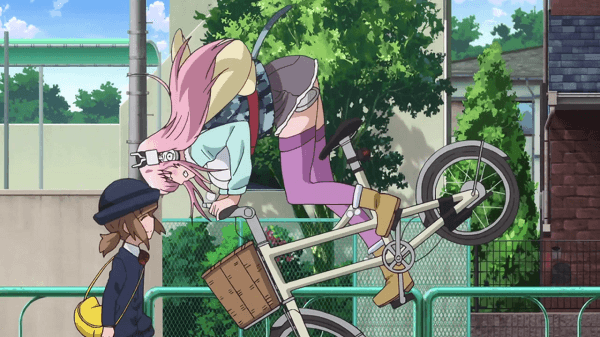
The series was given a 15 rating in the UK for strong sexual references. These moments are when Sonico is modelling and having to get in some provocative positions while wearing a lack of clothing. If these moments had been cut and Sonico wore a bit more clothing, the series could easily have gotten away with a 12 rating and would have been able to reach a wider audience because it was a teen comedy-drama.
Considering the source material
Super Sonico: The Animation was a lot better than it had any right to be because of its characters, heart-warming moments and its high quality animation. It's just a shame that certain scenes forced the show to have a high rating in the UK because if they had been edited it could have been seen by a younger audience.
Pros
- Likable characters
- Pulls on your heartstrings at the right moments
- Breathtaking animation
- Catchy songs for those who like Japanese music
Cons
- The English dub
- Super Sonico is too perfect
- Should have been targeted to a younger audience
 Unlike other anime series which have been reviewed by this website - Super Sonico: The Animation is a looser collection of episodes. Even though the episodes have some connection to each other they could be watched independently without much trouble or prior knowledge. The stories themselves are light-hearted if inconsequential affairs where Sonico prepare for gigs, going on modelling contracts, going on vacation, finding a kitten and saving the shopping district at Christmas.
Some episodes are more dramatic and heartfelt and others are more comedic in tone. The most emotional and best episode in the series is the fourth episode "Daydream" telling the story about how Sonico got her guitar in junior high. The heart of the episode is Sonico's relationship with an older student who teaches her how to play and gives the young teenager the confidence she needs. Other emotional episodes are the seventh episode "Star Rain", where Sonico travels to northern Japan to find inspiration and meets numerous people on the way and the Christmas episodes that ends the series. These are episodes that succeed in producing a warm internal fuzzy feeling at the end.
Unlike other anime series which have been reviewed by this website - Super Sonico: The Animation is a looser collection of episodes. Even though the episodes have some connection to each other they could be watched independently without much trouble or prior knowledge. The stories themselves are light-hearted if inconsequential affairs where Sonico prepare for gigs, going on modelling contracts, going on vacation, finding a kitten and saving the shopping district at Christmas.
Some episodes are more dramatic and heartfelt and others are more comedic in tone. The most emotional and best episode in the series is the fourth episode "Daydream" telling the story about how Sonico got her guitar in junior high. The heart of the episode is Sonico's relationship with an older student who teaches her how to play and gives the young teenager the confidence she needs. Other emotional episodes are the seventh episode "Star Rain", where Sonico travels to northern Japan to find inspiration and meets numerous people on the way and the Christmas episodes that ends the series. These are episodes that succeed in producing a warm internal fuzzy feeling at the end.
 The best of the comedic episodes is episode (or session) eight - "Super Sonico Murder Case" where Sonico is found unconscious in a locked room and Suzu's enthusiastic little sister Ena tries to play detective. This episode is the most overt in using anime tropes, using a simplistic, cartoony style of animation when Ena talks about her deductions and Ena has a wonderful anime introduction when she puts on her Sherlock Holmes deerstalker hat and stands in her dramatic pose. The third episode "Sonico Goes to Okinawa" parodies Super Sentai shows (the Japanese footage used in "Power Rangers" shows) and takes a swipe at the use of tentacle porn in anime.
The series is fairly grounded because of its focus on a normal group of people and the trials of daily tasks, but it doesn't mean that the series cannot have more outlandish moments. The best example is the sixth episode where the band goes on a cruise ship that ends up being infested with zombies. This comes completely out of left-field considering the rest of the series. Sonico's modelling manger, Kitamura, also appears to be from another anime show - dressed in a hannya mask, has pointed orange hair and carries a katana.
The best of the comedic episodes is episode (or session) eight - "Super Sonico Murder Case" where Sonico is found unconscious in a locked room and Suzu's enthusiastic little sister Ena tries to play detective. This episode is the most overt in using anime tropes, using a simplistic, cartoony style of animation when Ena talks about her deductions and Ena has a wonderful anime introduction when she puts on her Sherlock Holmes deerstalker hat and stands in her dramatic pose. The third episode "Sonico Goes to Okinawa" parodies Super Sentai shows (the Japanese footage used in "Power Rangers" shows) and takes a swipe at the use of tentacle porn in anime.
The series is fairly grounded because of its focus on a normal group of people and the trials of daily tasks, but it doesn't mean that the series cannot have more outlandish moments. The best example is the sixth episode where the band goes on a cruise ship that ends up being infested with zombies. This comes completely out of left-field considering the rest of the series. Sonico's modelling manger, Kitamura, also appears to be from another anime show - dressed in a hannya mask, has pointed orange hair and carries a katana.
 The winning feature of Super Sonico: The Animation is its likable cast of characters. Sonico herself is Mary Sue - she's a musician, a successful model and a student: even her teacher says she would be the perfect student if she could show up on time. Her only faults are that she gets embarrassed easily - too keen to apologize, too eager to help others and oversleeps. These are not major faults and she improves the lives of everyone she comes into contact with. Despite Sonico's lack of major issues she has a lovely on-screen presence and it is easy to see why people are drawn to her.
Two of the best supporting characters in Super Sonico are Suzu and Kitamura. Suzu is a dominating young woman who doesn't let anything get in her way, while Kitamura is at his best when he intimidates anyone trying to take advantage of Sonico. Fuuri is a character that everyone could easily envy because of her metabolism - being able to eat like a pig but does not get fat. Even though Ena only appears for one episode she was a fantastically energetic girl and a delight to see.
The winning feature of Super Sonico: The Animation is its likable cast of characters. Sonico herself is Mary Sue - she's a musician, a successful model and a student: even her teacher says she would be the perfect student if she could show up on time. Her only faults are that she gets embarrassed easily - too keen to apologize, too eager to help others and oversleeps. These are not major faults and she improves the lives of everyone she comes into contact with. Despite Sonico's lack of major issues she has a lovely on-screen presence and it is easy to see why people are drawn to her.
Two of the best supporting characters in Super Sonico are Suzu and Kitamura. Suzu is a dominating young woman who doesn't let anything get in her way, while Kitamura is at his best when he intimidates anyone trying to take advantage of Sonico. Fuuri is a character that everyone could easily envy because of her metabolism - being able to eat like a pig but does not get fat. Even though Ena only appears for one episode she was a fantastically energetic girl and a delight to see.
 Super Sonico: The Animation also has excellent animation throughout, mixing traditional hand drawn animation and CGI. The first episode opens with a gorgeous collection of establishing shots, showing people and animals in a park while cherry blossom leaves fall before meeting Sonico. The series is filled with moments like these - episode seven being the best example as it shows Sonico on her travels, the final concert that uses a CGI style of animation and episode six shows some horror influences when the girls run away from the zombies. One of the most famous aspects of the series was its end-credit sequences - having a different one for each episode. Some work better than others - ranging from Sonico dancing or being in a bikini - a homage to Michael Jackson's 'Thriller', Sonico becoming the 50-foot tall woman and a Sonico doll comes to life. These sequences are a great little treat to end the episodes.
It is advisable to watch the series in Japanese because the voice acting in the American dub is a mixed back. Sonico was voiced by Jessica Nigri, a celebrity cosplayer and Youtuber. Nigri was enthusiastic but clearly was not a trained voice actor. The American voice for Kitamura did not much match the character, it needed something more intense - even at his kindest - and Luci Christian, an experienced voice actor, who played Suzu was at times stilted with her delivery. Although the series focuses on a band that plays lots of pop-rock the opening theme song is J-pop. This is nitpicking because the theme song is a catchy ear-worm.
Super Sonico: The Animation also has excellent animation throughout, mixing traditional hand drawn animation and CGI. The first episode opens with a gorgeous collection of establishing shots, showing people and animals in a park while cherry blossom leaves fall before meeting Sonico. The series is filled with moments like these - episode seven being the best example as it shows Sonico on her travels, the final concert that uses a CGI style of animation and episode six shows some horror influences when the girls run away from the zombies. One of the most famous aspects of the series was its end-credit sequences - having a different one for each episode. Some work better than others - ranging from Sonico dancing or being in a bikini - a homage to Michael Jackson's 'Thriller', Sonico becoming the 50-foot tall woman and a Sonico doll comes to life. These sequences are a great little treat to end the episodes.
It is advisable to watch the series in Japanese because the voice acting in the American dub is a mixed back. Sonico was voiced by Jessica Nigri, a celebrity cosplayer and Youtuber. Nigri was enthusiastic but clearly was not a trained voice actor. The American voice for Kitamura did not much match the character, it needed something more intense - even at his kindest - and Luci Christian, an experienced voice actor, who played Suzu was at times stilted with her delivery. Although the series focuses on a band that plays lots of pop-rock the opening theme song is J-pop. This is nitpicking because the theme song is a catchy ear-worm.
 The series was given a 15 rating in the UK for strong sexual references. These moments are when Sonico is modelling and having to get in some provocative positions while wearing a lack of clothing. If these moments had been cut and Sonico wore a bit more clothing, the series could easily have gotten away with a 12 rating and would have been able to reach a wider audience because it was a teen comedy-drama.
Considering the source material Super Sonico: The Animation was a lot better than it had any right to be because of its characters, heart-warming moments and its high quality animation. It's just a shame that certain scenes forced the show to have a high rating in the UK because if they had been edited it could have been seen by a younger audience.
The series was given a 15 rating in the UK for strong sexual references. These moments are when Sonico is modelling and having to get in some provocative positions while wearing a lack of clothing. If these moments had been cut and Sonico wore a bit more clothing, the series could easily have gotten away with a 12 rating and would have been able to reach a wider audience because it was a teen comedy-drama.
Considering the source material Super Sonico: The Animation was a lot better than it had any right to be because of its characters, heart-warming moments and its high quality animation. It's just a shame that certain scenes forced the show to have a high rating in the UK because if they had been edited it could have been seen by a younger audience.